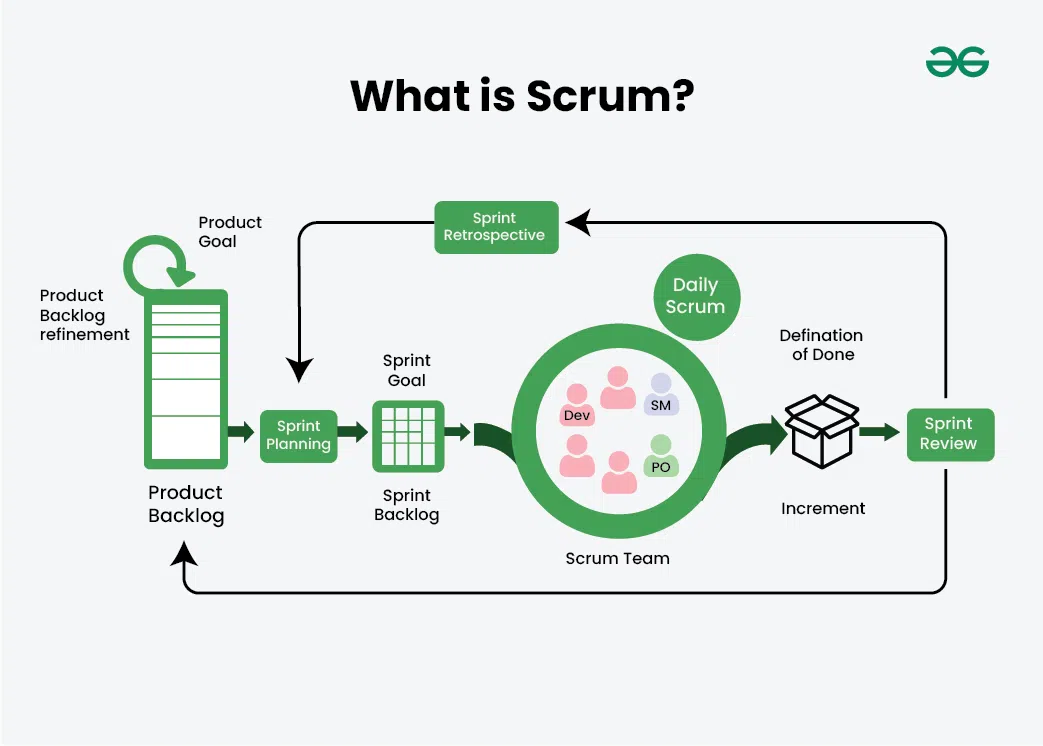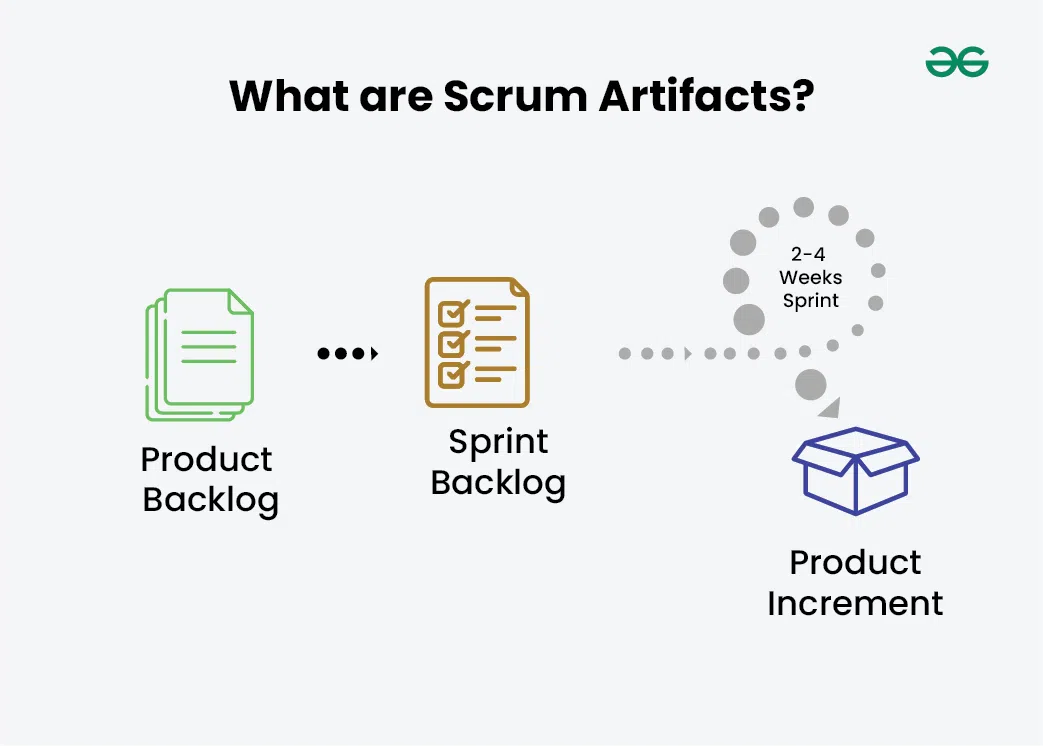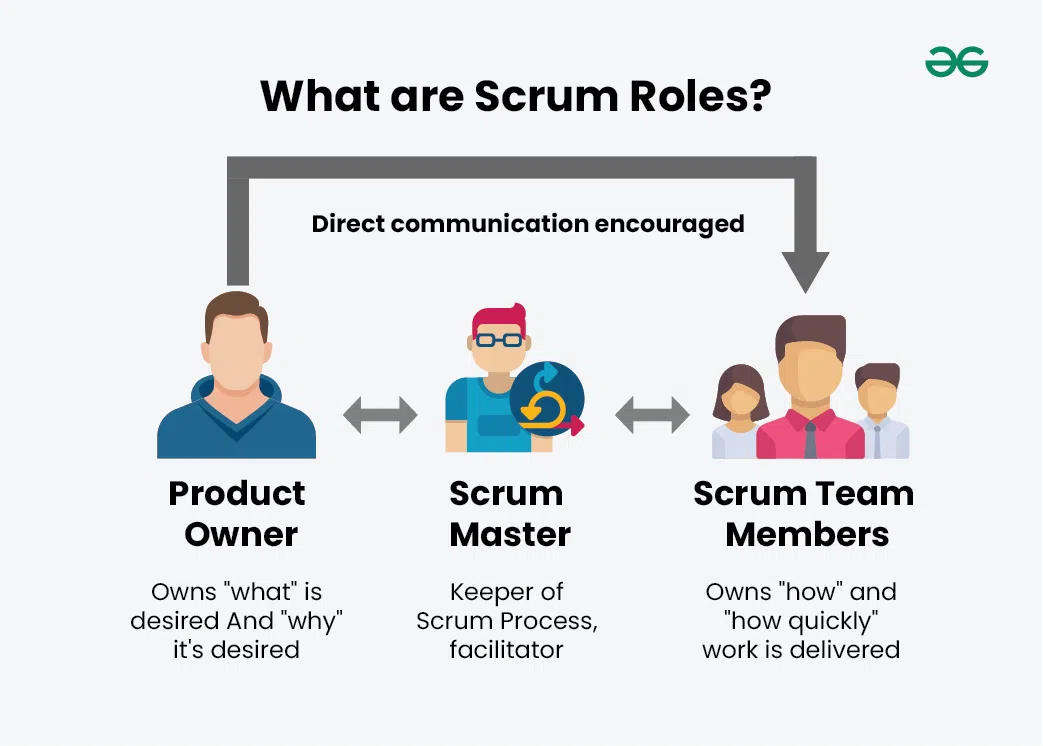
|
|
In the ever-evolving world of project management, one term that frequently pops up is “scrum.” But what is Scrum? In simple terms, Scrum is a popular framework used in agile project management, designed to enhance collaboration, adaptability, and efficiency within teams. The Scrum framework has been used since the early 1990s. Scrum is a framework that can be used for building products. This article focuses on discussing Scrum in detail. So, let’s delve deeper into what Scrum entails, its key principles, and how it revolutionizes the way teams work together to deliver high-quality results. Table of Content What is Scrum?If we define Scrum in simple terms, then Scrum is a way of managing projects, especially in software development. It’s like a playbook that teams use to work together more effectively. Instead of doing everything at once, Scrum breaks work into smaller parts called “sprints.” Each sprint focuses on completing a specific piece of the project, allowing teams to adapt and improve as they go. It’s all about teamwork, communication, and getting things done step by step. Scrum is a popular framework that is used whenever we want to develop complex products, Ken Schwaber and Jeff Sutherland are known as the people who developed Scrum.  What is Scrum
The Scrum FrameworkThe Scrum framework is a simple, agile way to manage projects that helps teams work together to create high-quality products quickly. Here are the basic components and principles of Scrum, explained in simple terms. Scrum Team
Artifacts:
Events:
Key Terminologies of ScrumHere are some of key terminologies of Scrum:
 Key Terminologies of Scrum What is Scrum Methodology?Here are some of the following principles and values that characterize Scrum methodology: Scrum Principles for Project Success
Scrum Values for Project Teams
How does Scrum Work?Scrum divides projects into smaller, more manageable units called “sprints,” which span two to four weeks on average. During these sprints, cross-functional teams work together to generate product increments that might potentially be shipped. It uses tools like the product backlog and sprint backlog, as well as regular events like sprint planning, daily stand-ups, sprint reviews, and retrospectives, to promote transparency, inspection, and adaptation. In the end, this helps teams respond rapidly to changes and produce value iteratively. What are Scrum Artifacts?There are three main agile scrum artifacts which are mentioned below:
 What are Scrum Artifacts What are Scrum Roles?Following are the various roles in the scrum, these are the most commonly known and used widely in the industry:  What are Scrum Roles
What are Sprints in Scrum?Whenever we build projects or products we do it in series of repetitions and these repetitions are known as sprint, sprint helps the developers of the project to build projects with higher productivity and functional. sprints are just a series of steps involved in a time-frame or duration that deals with the overall development of the product.
What is Sprint Process?Step 1: The scrum cycle is a complete cycle of product development which starts with the Product Owner, the product owner defines all the product backlog and requirements for further development. Step 2: The next step is handled by the scrum team and the scrum team manages the Sprint Planning in the sprint planning phase the team plans all the tasks and roles for the development of the product. Step 3: Then in the next phase the team deals with the sprint backlogs which are due and deals accordingly with all the backlogs left. Step 4: As we know the scrum master is someone who overseas all the tasks of the team and acts as a mentor for the team, so in this step the scrum master overseas and collaborates with the team to make sure the product is ready on time, this cycle typically lasts from 1 to 4 weeks but depending on the project size it varies a lot, which is why sometimes for larger projects, it’s also divided into smaller part known as Daily Scrum. Step 5: This is the final process stage, in this stage the team integrates all the modules of the project and tests the various components of the product. Below is the visual representation of the Scrum’s sprint process:  Scrum Cycle Applications of ScrumWe use the scrum framework because it provides us with a flexibility and an iterative approach to do product development and whenever we do product or software development. The scrum framework allows us to respond with the teams quickly when we have changing requirements which helps us in delivering values incrementally let’s understand some common applications of scrum: 1. Software Development
2. Scrum in MarketingThe scrum framework can also be used in the marketing in order to manage and execute various campaigns we can use the scrum because it enables marketing professionals so that they can respond quickly to the changes of the market and according to those changes they can test different strategies and then optimise their campaigns more efficiently. 3. Social & Non Profit SectorThis framework can also be applied in the social sector as well as the non profit organization’s industry to manage various projects efficiently as it allows these organisations to be more adaptive and to be more responsive to the various needs of the community that they serve which can lead to overall growth. 4. Any Complex ProjectNo matter what sector we are working on the scrum is suitable for any project that deals with complex requirements which are changing with time because when we are working with the product that has changing requirements then using an incremental approach is always beneficial. 5. R&D (Research and Development Sector)The scrum framework is useful in under industries where we have the work of research and development as we can use the scrum framework to manage ongoing projects and prioritise them accordingly as we manage and prioritise various products and projects it will allow the team of development and researchers to experiment and adapt various approach based on feedback that they receive regularly. Benefits of ScrumNow that we have seen the applications of scrum let’s move on to discussing the benefits of the scrum framework, If the scrum framework is implemented in the right way it can offer numerous benefits for the organizations as well as the teams who are involved in the project management or product development let’s see some key advantages of using the scrum framework: 1. Faster Development
2. Transparency in all StagesIn the scrum framework the transparency is a fundamental principle which enables clear communication at all the stages of a project being developed this transparency helps everyone such as the teams stakeholders as well as the organizations to understand the challenges progress as well as the outcome of their work in a scrum framework transparency is handled using various techniques such as product backlog sprint backlog sprint review daily standup meetings etc. 3. Time-efficientScrum framework is also known for its focus on the time efficiency because it uses the iterative development it allows for short cycles known as sprints which allows continuous improvement the scrum framework allows us to use several practices or principles which contribute to make sure that the projects we are making are more time efficient scrum handles time management through.
Apart from that it also uses a concept of time boxed meetings in which various ceremonies such as the sprint planning, daily standup sprint review are time boxed meaning that they have a certain limit of time to finish these meetings the time boxing method allows us to do task in less time which ultimately leads to efficiency of time. 4. Budget-friendly PlanningThe budgeting is an important role in the project management In order for us to maximise the revenue of the company we have to make sure that whatever product or project we are building is budget friendly the scrum framework allows us to manage products within our budget because it follows various principles that helps us to prioritise the important factors of the project and it also allows us to reduce the wastage through following the incremental approach while dealing with new features. Limitations of ScrumAs any other framework used in the product development the scrum also has some limitations in it as we have discussed applications and the advantages of using the scrum framework we also have to take into consideration of the limitations of this framework here are some common limitations of the scrum framework: 1. Not Suitable for All Projects
2. Requires Skilled & Experienced Team
3. Limited Predictability
4. Lack of Detailed Documentation
5. Risk of Team Burnout
Agile Vs ScrumHere is a table that represents the difference between agile and scum:

Conclusion:In conclusion, the scrum provides us a methodology to deal with the product development cycle and also provides us all the necessary guidelines to deal with the day to day tasks and also provides us with the opportunity to make sure to develop projects with higher functionality in lesser time and efforts. The scrum methodology is used in various software industrial development process and provides us a better way to understand the projects and build the project with more efficiency. Frequently Asked Questions on Scrum- FAQ’sIs Jira a scrum tool?
Which tool is used for scrum?
What is better than Scrum?
|
Reffered: https://www.geeksforgeeks.org
| Agile |
| Related |
|---|
| |
| |
| |
| |
| |
Type: | Geek |
Category: | Coding |
Sub Category: | Tutorial |
Uploaded by: | Admin |
Views: | 14 |